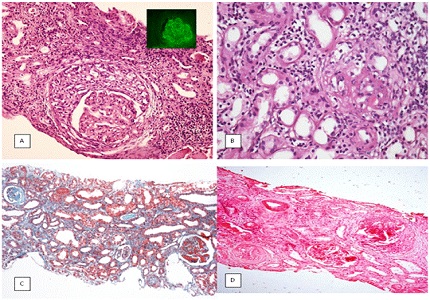Crescents in renal biopsies and crescentic glomerulonephritis - A 5 year study from South India
Abstract
Background: Crescents indicate active disease with rapidly deteriorating renal function. Many primary renal diseases can be associated with crescents, however only a few conditions presents as crescentic glomerulonephritis(CrGN) . The incidence varies in different population.
Aims and objective: The aim of the study was to know the incidence of CrGN and that of crescents in various glomerulopathies along with their clinicopathological associations.
Material and methods: Renal core biopsies over 5 year period were collected retrospectively from pathology archives and reviewed for crescents and CrGN. Clinical , serological, Immunoflourescence and follow up details were collected.
Results: A total of 1629 renal biopsies were received. Crescents were identified in 9.69% and 2.08% were CrGN. Males and females were equally distributed. Paediatric population constituted 24%. The most common presentation was nephritic syndrome. Cellular crescents were seen in 81 cases, fibro cellular/ fibrous in 55 cases and both in 22 cases. In immune complex(IC) mediated group, lupus nephritis (LN) showed crescents in 31.7%, followed by PIGN (29.67%) and IgAN (25.2%). Vasculitis group had 79% crescents. All cases of anti GBM disease and pauci immune ANCA negative renal limited vasculitis(PI-RLV) had crescents. The most common CrGNs were anti GBM disease (100%), followed by vasculitis (37%) and PI-RLV (33%) and least in IC group (5% in PIGN and IgAN and 3.5% in LN). Complete remission was seen in 32.2%.
Conclusion: Crescents in renal biopsies are not rare. Although CrGN is more common in vasculitis and anti-GBM disease, the incidence of IC-GN is more in our population and a significant number may show crescents.
Downloads
References
2. Jennette JC, Thomas DB. Crescentic glomerulonephritis. Nephrol Dial Transplant.2001; 16(suppl 6):80-82 DOI: http://dx.doi.org/10.1093/ndt/16.suppl_6.80.
3. Mathieson PW. The ins and outs of glomerular crescent formation. Clin Exp Immunol. 1997 Nov;110(2):155-7. [PubMed]
4. Jennette JC , Nickeleit V. Anti Glomerular Basement Membrane Glomeruloephritis and Goodpasture’s syndrome.In:Jennette JC,Olsen JL,Schwartz MM, Silva FG,editors.Heptinstall’s Pathology of the kidney.6th ed. Philadelphia: Lippincott Williams & Wilkins; 2007.p.613- 641.
5. Osler S. Extracapillary glomerulonephritis: A semiquantitative light microscopical study of 59 patients. Acta Pathol Microbiol Scand[A] 1974;Suppl 249:7.
6. Gupta R, Singh L, Sharma A, Bagga A, Agarwal SK, Dinda AK. Crescentic glomerulonephritis: A clinical and histomorphological analysis of 46 cases. Ind J Pathol Micro .2011; 54(3): 497-500 DOI: http://dx.doi.org/10.4103/0377-4929.85081.
7. Tang Z, Wu Y, Wang Q, Zeng C, Yao X, Hu W, Chen H, Liu Z, Li L. Clinical spectrum of diffuse crescentic glomerulonephritis in Chinese patients. Chin Med J (Engl). 2003 Nov;116(11):1737-40.
8. Jennette JC, Falk RJ. Antineutrophil Cytoplasmic autoantibodies and associated diseases: A review. Am J Kid Dis 1990;15(6):517-25.DOI: http://dx.doi.org/10.1016/S0272-6386(12)80521-X.
9. Andrassy K, Kuster S, Waldherr R, Ritz E. Rapidly progressive glomerulonephritis, analysis of prevalence and clinical course. Nephron 1991; 59(2):206-12. DOI: http://dx.doi.org/10.1159/000186552.
10. Zent R, Van Zyl Smit R, Duffield M, Cassidy MJ. Crescentic Glomerulonephritis at Goote Shuur Hospital, South Africa, not a benign disease. Clin Nephrol 1994; 42(1):22-9. [PubMed]
11. Pettersson EE, Sundelin B, Heigl Z. Incidence and outcome of pauci-immune necrotizing and crescentic glomerulonephritis in adults. Clin Nephrol. 1995 Mar;43(3):141-9. [PubMed]
12. Choudhury TA, Singh RG; Usha, Singh S, Singh TB, Rathore SS; Prabhakar. Clinicopathologic spectrum of crescentic glomerulonephritis: a hospital-based study. Saudi J Kidney Dis Transpl. 2014 May;25(3):689-96.
13. Jardim HM, Leake J, Risdon RA, Barratt TM, Dillon MJ. Crescentic glomerulonephritis in children. Pediatr Nephrol. 1992 May;6(3):231-5. [PubMed]
14. Srivastava RN, Moudgil A, Bagga A, Vasudev AS, Bhuyan UN, Sunderam KR. Crescentic glomerulonephritis in children: a review of 43 cases. Am J Nephrol. 1992; 12(3):155-61.DOI: http://dx.doi.org/10.1159/000168438.
15. Dewan D, Gulati S, Sharma RK, Prasad N, Jain M, Gupta A, et al. Clinical spectrum and outcome of crescentic glomerulonephritis in children in developing countries. Pediatr Nephrol. 2008;23(3):389-94. DOI: http://dx.doi.org/10.1007/s00467-007-0647-3.
16. Sinha A,Puri K, Hari P, Dinda A K,Bagga A. Etiology and outcome of crescentic glomerulonephritis. Indian Pediatrics.2013; 50(3):283-288 DOI: http://dx.doi.org/10.1007/s13312-013-0095-z.



 OAI - Open Archives Initiative
OAI - Open Archives Initiative


